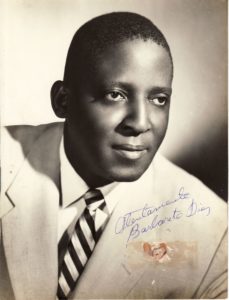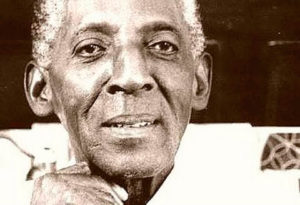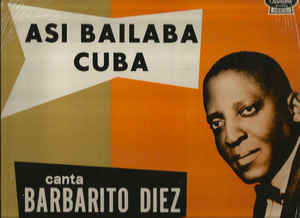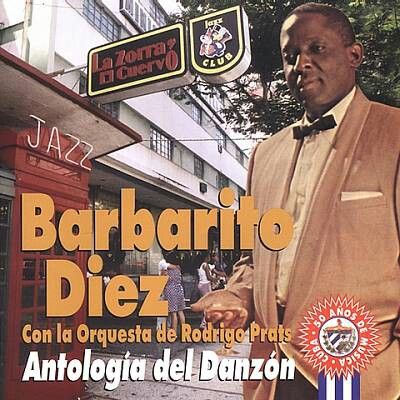 “EL PRÍNCIPE DEL DANZÓN”, BARBARITO DIEZ. VIDEOS.
“EL PRÍNCIPE DEL DANZÓN”, BARBARITO DIEZ. VIDEOS.
Barbarito Diez Junco nació un 4 de Diciembre de 1909 en Bolondrón, Provincia de Matanzas en la localidad donde estaba el hoy demolido central azucarero San Rafael de Jorrín y quien, con el decursar del tiempo se convirtiera en “El Príncipe del Danzón”.
A los 4 años junto a su familia, se traslada, al entonces central Manatí Sugar Company, actualmente demolido también en el municipio de Manatí, Provincia de Las Tunas, donde su padre, Eugenio Diez trabajaba como obrero. Barbarito no fue ni Sastre ni mecánico como deseaban algunos miembros de su familia. Sus caminos eran otros.
En el año 1930 se traslada definitivamente para La Habana donde comienza a cantar en trío de Graciano Gómez e Isaac Oviedo, contando con solo 21 años comenzó una carrera artística en la cual alternó con la Orquesta Danzonera de Antonio María Romeu, con la cual se dio a conocer. Barbarito no tuvo una formación musical académica, no tocaba ningún instrumento, pero su inigualable voz y sus interpretaciones musicales lo convirtieron en ídolo público, su voz inmortalizó páginas musicales como Martha del compositor Moisés Simmons, Lágrimas Negras, Olvido, Juramento, El que Siembra su Maíz de Miguel Matamoros, entre otros.
Por lo general actuaban en la peña del Café “Vista Alegre” entonces ubicado en San Lázaro y Belascoaín, donde ya Barbarito mostraba la elegancia que lo caracterizó durante más de cinco decenios de vida artística. Sobre el referido lugar Eduardo Robreño, teatrista y periodista, ofrece una valoración en su libro “Cualquier Tiempo Pasado Fue”… “no sería aventurado decir que medio centenar de las más gustadas melodías de nuestro cancionero popular surgieron o se esbozaron allí y es que el Vista Alegre fue centro perenne de reunión de los mejores cultores de la trova.
De velada en velada y de baile en baile por toda Cuba y Latinoamérica anduvo Barbarito. Deleitó a varias generaciones con obras de Ernesto Lecuona, Moisés Simmons, Eliseo Grenet, Pedro Flores, Rafael Hernández y otros destacados compositores al abrigo de guitarras, pianos y tambores, Barbarito desplegó su virtuosismo y encanto singular, porte erguido, sereno de Palma Real.
En su carrera de más de 58 años grabó gran número de discos de larga duración que contenían obras que enriquecen el repertorio musical cubano. Viajó a los países de América, Europa y E.E.U.U., realizó programas en Cabaret, Teatros, Bailes, la Radio y la TV.
Jamás aprendió los fundamentos teóricos del arte musical, pero demostró ser uno de los más afinados y consecuentes del Danzón, un género que como ritmo permanece hasta en la misma Salsa a pesar de contar con más de 100 años de creado. Su voz única e irrepetible se escuchó en México, Venezuela, República Dominicana y Panamá entre otros escenarios del mundo logrando a lo largo de su fructífera carrera, el título de: “La Voz de Oro del Danzón”, o “El Príncipe del Danzón”.
Contó con el acompañamiento del maestro Antonio María Romeu, quién además de introducir el piano en su orquesta para interpretar danzones, tenía un modo peculiar de tocar ese instrumento. Impresionaba con su estilo, técnica y escalas inigualables. En tanto que la voz por excelencia de “Tres Lindas Cubanas” y de otras páginas antológicas aportó bríos mesurados y originales a la forma danzaria y cantable reconocida como nuestro baile nacional. Por eso resulta difícil mencionar a la Orquesta de Antonio María Romeu sin añadir, a su cantante Barbarito Diez.
Su voz melodiosa recreó como ninguna otra obras musicales como ‘Idilio’, ‘Ojos Malvados’, ‘Junto al Palmar del Bajío’ y ‘La Rosa Roja’.
Cantantes y artistas como Alfredo Sadel y Simón Díaz, músicos Venezolanos amigos de Cuba, lo definieran como una de las grandes voces de América Latina. “Entregaba en cada interpretación por encima de todos sus logros formales (méritos y rítmicos) una atmósfera auténtica, sangre de su vida”, comentó Díaz.
En su larga vida artística Barbarito trascendió a otros géneros como el entonces muy popular Cha Cha Chá que reconoció como “una magnífica modalidad del Danzón que ha prendido en el corazón del cubano. lo aceptó como algo nuestro al igual que al Danzón. Ambas ramificaciones saben a son cubano” dijo.
La Habana, 6 de Mayo de 1995 al fallecer cumpliría ya 86 años el 4 de Diciembre, contaba con las distinciones “Por la Cultura Nacional” y “Raúl Gómez García”, además de la medalla “Alejo Carpentier” y la “Orden Félix Varela de Primer Grado”, entre muchos galardones, reconocimientos y trofeos. Toda una vida por su firme calidad entroncó con lo mejor de nuestra tradición musical.
Aquel gigante de la música cubana, Barbarito Diez siempre estará entre nosotros, como un gigante del pentagrama de su majestuosa figura, que cual Palma Real se yergue en el Centro de la Cultura Nacional y en el corazón de nuestro pueblo que permanentemente le rinde Homenaje.
En honor a la memoria de Barbarito Diez, el municipio de Manatí, construyó un monumento el cual está situado en el parque José Martí de dicho territorio, además de una casa para su descanso que actualmente es la Casa de la Música “Barbarito Diez”
 “EL PRINCE OF DANZÓN”, BARBARITO DIEZ. VIDEOS.
“EL PRINCE OF DANZÓN”, BARBARITO DIEZ. VIDEOS.
Barbarito Diez Junco was born on December 4, 1909 in Bolondrón, Province of Matanzas in the town where the now demolished sugar mill San Rafael de Jorrin was and who, with the passing of time became “The Prince of Danzón.”
After 4 years with his family, he moved to the then Manati Sugar Company, currently in the process of demolition in the municipality of Manati, Province of Las Tunas, where his father, Eugenio Diez worked as a worker.
Barbarito was neither Sastre nor mechanic as some members of his family wanted. His ways were others.
In 1930 he moved permanently to Havana where he began to sing in a trio of Graciano Gómez and Isaac Oviedo, counting with only 21 years old he started an artistic career in which he alternated with Antonio Maria Romeu’s Danzonera Orchestra, with which to know. Barbarito did not have an academic musical training, he did not play any instrument, but his unparalleled voice and musical interpretations made him a public idol, his voice immortalized music pages such as Martha by composer Moisés Simmons, Lágrimas Negras, Olvido, Oath, El Siembra su Maize of Miguel Matamoros, among others.
They usually performed at the “Vista Alegre” Café, then located in San Lázaro and Belascoaín, where Barbarito already showed the elegance that characterized him during more than five decades of artistic life. About the aforementioned place Eduardo Robreño, playwright and journalist, offers an assessment in his book “Any Time Past Was” … “it would not be risky to say that fifty of the most liked melodies of our popular songbook arose or were sketched there and is that the Vista Alegre was a perennial meeting place for the best musicians of the trova.
From evening to evening and from dance to dance throughout Cuba and Latin America, Barbarito walked. He delighted several generations with works by Ernesto Lecuona, Moisés Simmons, Eliseo Grenet, Pedro Flores, Rafael Hernández and other outstanding composers sheltered by guitars, pianos and drums, Barbarito displayed his virtuosity and singular charm, erect, serene carriage of Palma Real.
In his career of more than 58 years he recorded a large number of long-playing albums containing works that enrich the Cuban musical repertoire. He traveled to the countries of America, Europe and the United States. He made programs in Cabaret, Theaters, Dances, Radio and TV.
He never learned the theoretical foundations of musical art, but he proved to be one of the most refined and consequential of the Danzón, a genre that, as a rhythm, remains even in the same Salsa despite having more than 100 years of creation. His unique and unrepeatable voice was heard in Mexico, Venezuela, the Dominican Republic and Panama among other stages of the world, achieving throughout his successful career, the title of “The Golden Voice of the Danzón”, or “The Prince of Danzón” .
He had the accompaniment of the maestro Antonio María Romeu, who in addition to introducing the piano into his orchestra to perform danzones, had a peculiar way of playing that instrument. He impressed with his style, technique and unparalleled scales. While the voice par excellence of “Tres Lindas Cubanas” and other anthological pages provided measured and original energy to the dance and singing form recognized as our national dance. That is why it is difficult to mention the Antonio María Romeu Orchestra without adding, to its singer Barbarito Diez.
His melodious voice recreated like no other musical works like ‘Idyll’, ‘Evil Eyes’, ‘Next to the Palmar del Bajío’ and ‘The Red Rose’.
Singers and artists such as Alfredo Sadel and Simón Díaz, Venezuelan musicians friends of Cuba, defined him as one of the great voices of Latin America. “He delivered in each interpretation, above all his formal achievements (merits and rhythms), an authentic atmosphere, the blood of his life,” commented Díaz.
In his long artistic life Barbarito transcended other genres such as the then very popular Cha Cha Chá, which he recognized as “a magnificent modality of the Danzón that has caught on in the heart of the Cuban, he accepted it as something of ours as well as the Danzón. They are Cuban, “he said.
Havana, May 6, 1995 at the time of his death he would already be 86 years old on December 4, had the distinctions “For the National Culture” and “Raúl Gómez García”, in addition to the medal “Alejo Carpentier” and the “Order Félix Varela” First Grade “, among many awards, recognitions and trophies. A lifetime for its firm quality connected with the best of our musical tradition.
That giant of Cuban music, Barbarito Diez will always be among us, like a giant of the pentagram of his majestic figure, which Palma Real stands in the Center of National Culture and in the heart of our people who are always paying homage to him.
In honor of the memory of Barbarito Diez, the municipality of Manatí, built a monument which is located in the José Martí park of that territory, in addition to a house for rest that is currently the House of Music “Barbarito Diez”
Agencies/ Manati Dist./ Internet Photos/ YouTube/ Arnoldo Varona/ www.TheCubanHistory.com
THE CUBAN HISTORY, HOLLYWOOD.








